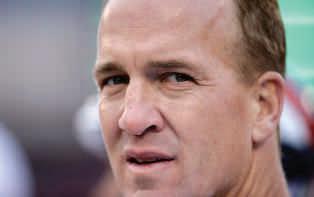
18 minute read
Transforming Lives for

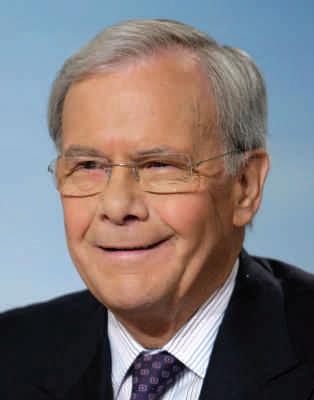
Transforming Lives for Cleft Patients
Cleft lip and palate is a very common birth defect – about 1 in 700 babies are born with it. While advances in treating patients with cleft lip and palate have evolved, one thing remains the same. People born with cleft are resilient and downright tough.
Take Peyton Manning, one of the most skilled and talented NFL quarterbacks, or Australian soccer star Ljubo Milicevic. Other widely known people with cleft include dentist and gunfighter Doc Holliday, civil rights activist Jesse Jackson, newsman Tom Brokaw, and many more athletes, politicians, authors, artists and actors.
The Pediatric Cleft and Craniofacial Anomalies Center, part of the Golisano Children’s Hospital, is a team of specialists from pediatric and plastic surgery, pediatric medicine, dentistry, audiology, and speech and language and social work to address and treat patients’ needs. For babies born with cleft lip and/or palate, the Center partners with Eastman Dental during the early stages and then later for orthodontics.
In the beginning, cleft babies often struggle to thrive because feeding is difficult. They undergo painful surgeries as infants, children and teens, and work hard to overcome big challenges with hearing, speech and their dentition. Perhaps these experiences have helped shape their strong determination and fortitude throughout life.
In 1950, a young couple had a baby boy with cleft lip and palate. The baby’s father was an aspiring oral surgeon and his mother becoming an English teacher. But due to their son’s condition, they decided to switch their careers to accommodate his needs.
Instead, the baby’s mother Joanne became a speech pathologist and the baby’s father, J. Daniel Subtelny, DDS, became an orthodontist after studying at the University of Illinois, known for its reputable program and cleft palate team. He later joined the faculty there, and served on the cleft team, treating dozens of kids with cleft lip and palate before starting the orthodontic program at Eastman Dental Dispensary in 1955.
Businessman Dan Lane, 42, was one of those kids treated at Eastman Dental on Main Street, and still has vivid memories.

Lane’s mother, Kathleen O’Connell, said Dan was a pretty good patient, so he was frequently chosen to help educate the residents.
“It felt like 100 doctors looking at me,” he said, laughing. “I remember all of these doctors opening my mouth and every year getting a new dentist, and thinking how long am I going to have to wear these braces?”
O’Connell remembers the numerous surgeries, with his lip repair occurring at 5 months old and palate closure at age 1. “They had to put his arms in braces because he tore some stitches with his hands on the second surgery. Throughout the years, the experience at Strong and Eastman were wonderful,” she said.
Lane ended up wearing braces for 10 long years, but it was the social aspect of having a cleft lip that was the hardest for him. He remembers avoiding other kids with cleft. “Even at Eastman Dental, when we would go for appointments and see other kids with cleft,” he said, “we would look at each other and quickly put our heads down.”
And then there were the school bullies, who always found the kid who looks a little different, whether it was a bad haircut or a scarred lip.
“Being a good athlete helped a lot,” said Lane, who is a sales manager for American Products, and coaches his daughter’s soccer team. “If I didn’t work harder and get better in sports, I knew I’d be forgotten about”
Subtelny agreed, and encouraged his son Gregory to excel in sports to help build his self-esteem and confidence. “He became an outstanding soccer player, swimmer and broke high school cross country records,” he said about Greg, who today enjoys practicing general dentistry in Ithaca.
“I think cleft kids definitely develop a thicker skin,” Lane continued, “and it just makes them stronger. For me, things just don’t affect me as much. When you have something so visual, it gives you some humility and sensitivity, and it makes you kinder.”
So when he noticed Marina DelVecchio, who played in the same soccer league, he was happy to reach out. They first met a couple years ago at a mutual friends’ cookout, and they both knew right away they shared a commonality.
“I knew that Mr. Lane had a cleft because of the way he looked a little different,” said Marina, who is now 12. “His lip wasn’t repaired as well as mine so it stood out a little more.”
Marina is on her fourth year of braces, with no end in sight. “She rarely complains,” said her mother, Tara. Marina was born with a unilateral cleft lip and palate and had her lip and palate repair done by plastic surgeon Joseph Losee, MD. They would visit with the cleft team once a year until Marina was 6, and then see John Girotto, MD who replaced Losee, as needed.
“Before her first surgery, I was dreading having her smile change – my husband had to convince me that she had to have the surgery!” Tara said. Breastfeeding attempts failed, and as a toddler she developed a lot of eating issues and food aversions, which she eventually outgrew. “But she is very tough physically and has come through her last few surgeries surprisingly well,” Tara added. “Codeine is almost always prescribed and she takes only one dose, if that. She gets a soccer ball in the face and rarely wants to come out of the game. She usually has a fever of 103 before I even know she is sick.”
Other than one friend asking her if she broke her nose, Marina has never been asked a lot about her cleft.
“My friends usually don’t ask questions and I usually don’t share information,” Marina said. “The times I am most uncomfortable are when I have a surgery and I have to be excused from gym. Then everybody knows and starts asking questions.”
Despite her discomfort, Marina chose clefts for her 6th grade school project that involves research and a call to action that can positively impact the world.
“I chose cleft for my topic because it is personal and it relates to me,” explained Marina, who interviewed Dan Lane as part of her research. “I also wanted to make people aware of this defect and give them a way to help through my action, which was to create a website that people can go on and donate to the organization Operation Smile.”
Marina not only surpassed her fund raising goal, but doubled it to allow two children

Cleft lip patients Marina DelVecchio and Dan Lane participate in the same soccer league.
living in a third world country to undergo lip and palate surgery. Her presentation was so well received, that Marina was the only student selected in the 6th grade to present her project to the whole school.
Another patient, Jim Nowakowski, 25, had a very different experience.
“I was always comfortable talking about my palate when I was younger and growing up,” he said. “My friends would ask me about my surgeries, because they were interested. And I would always enjoy educating them about it. I am fortunate my experience was never really bad, but I do remember kids making remarks because I had braces at such a young age, but kids saying things about braces was always common anyway.”
Since Nowakowski’s first surgery at 5 ½ months old, he’s been back to Strong and Eastman Dental countless times for procedures and surgeries. Like most cleft patients, he had bone removed from his hip to fill in the gap on his upper jaw, which wasn’t growing properly. But his lower jaw was growing on schedule, resulting in a severe under bite that wouldn’t allow his teeth to meet.
Joseph Fantuzzo, DDS, MD, chair, EIOH Oral and Maxillofacial Surgery Division performed his jaw surgery in 2006, leaving his mouth wired for 5 weeks, unable to eat anything that wouldn’t fit through a straw.
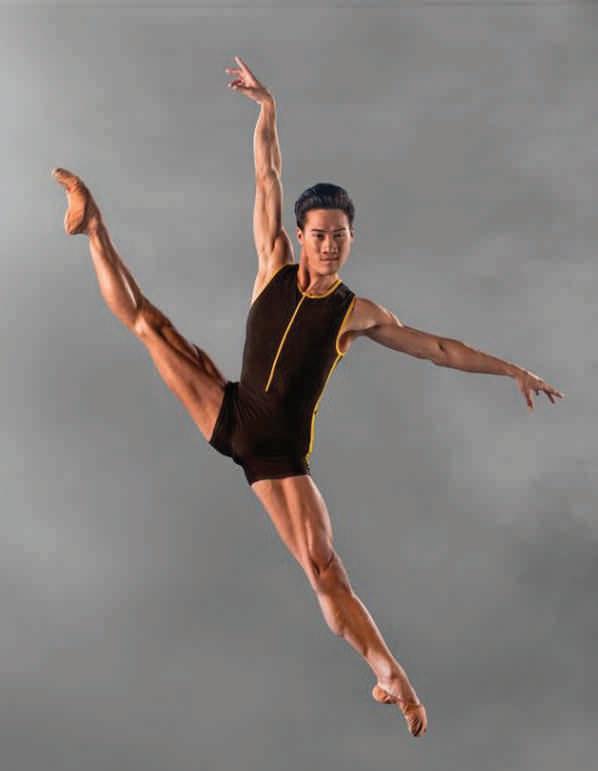
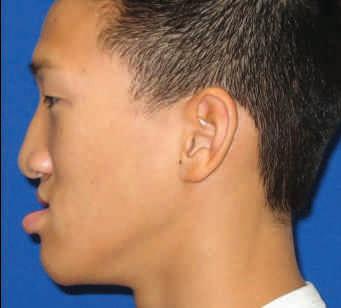
Photo by Amitaya Sarkar. © Houston Ballet.

Acclaimed ballet dancer Jim Nowakowski has been an Eastman Dental/UR Medicine patient for 25 years undergoing cleft repair, bone grafts, orthodontics, oral and maxillofacial surgery and plastic surgery.
BEFORE
Nowakowski underwent plastic surgery at URMC for nose and scar repair.
“When you start at such a young age, all the appointments and surgeries become part of your life,” he said. “Everyone always made it very easy and comfortable. I have warm memories of that time.”
After 13 years, he finally got his braces removed and moved to Texas to join the Houston Ballet at age 18. Nowakowski began his formal training locally, performed with the Rochester City Ballet, and was promoted last year to demi soloist. He has earned many awards for his performances, including the National Foundation for Advancement in the Arts Gold Award in Dance, which was presented to him by Mikhail Baryshnikov. An interview with Nowakowski on YouTube has nearly 107,000 views.
Nowakowski said he rarely sees anyone with a cleft, but recently met a friend’s 7 year old nephew with a bilateral cleft and they have since become pen pals.
“I’m happy to connect with him, and be a role model if he needs it,” he said. A couple years ago, Nowakowski returned to Rochester to have additional work on his nose and scar from Dr. Girotto. “I’m very happy with the result,” he said.
When Nowakowski’s dance career is over (late 30’s for most dancers), he wants to transition into coordinating galas and dance performances that benefit charities, including helping people with cleft lip and palate.
AFTER

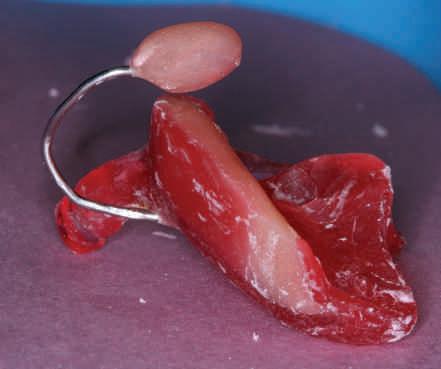
Introducing the NAM
Considered by many as a cutting edge for presurgical treatment for infants with cleft, the Nasoalveolar molding technique (NAM) was pioneered in the late 1980’s by Barry H. Grayson, DDS, clinical associate professor at NYU’s Langone Medical Center. The NAM looks somewhat like a retainer, and over time, it helps align the baby’s bone and gums where the teeth will grow in, as well as help create a more natural looking nose. By reducing the size of the cleft, there is less tension created at the surgery site, helping improve the surgical result and reducing the number of surgeries needed.
Eastman Dental did a little work with the NAM in the late ‘90’s but it wasn’t until early 2006 that an organized effort began when Jeffrey Karp, DDS, the previous EIOH Pediatric Dentistry program director, went to NYU to train with Grayson.
To be successful, the NAM takes a huge commitment and a lot of work from the parents. That didn’t deter Lindsay Kolk, who knew she wanted her newborn daughter Sierra to undergo the NAM treatment. Sierra was one of Eastman Dental’s first patients to use the NAM, beginning treatment at 10 days old by getting an impression of her mouth and nose.
Lindsay and Sierra drove two hours from Elmira to Eastman Dental every week to have Sierra’s NAM adjusted. At home, taking care of a cleft baby and managing the NAM can be labor intensive. As a result, Lindsay quit her job; but, she says, it was well worth it.
Sierra’s gap closed from its original 17mm at birth to 4 mm before her first surgery at 5 months.
Today, at age five, Kolk says Sierra is adventurous and creative. “And ridiculously tough,” added Kolk, who wrote a blog, Looking for Strawberries, about her experiences with the cleft and the NAM. “She’s never cried getting a shot in the doctor’s office, and is always the first one jumping off of things and doing flips. She’s definitely not the cautious child!”
Sierra, whose speech has been affected with the cleft, underwent surgery last summer which took a flap of skin in the back of her throat and attached it to the soft palate. The flap forms a bridge to close the gap between the back of the throat and soft palate, therefore correcting her hypernasal speech.
“So far, the surgery has helped with her nasality,” Kolk said. “It’ll take time to see how good it gets, but Sierra works very hard for her speech, and gets therapy daily.”
Lindsay and Sierra continue to meet with the Cleft and Craniofacial Anomalies Center, led by Dr. Girotto who has recently taken a new position in Grand Rapids, Michigan. Clinton Morrison, MD, who is finishing a fellowship in Craniofacial Surgery from Seattle Children’s Hospital, will replace him.

“We see around 20-30 new cleft patients per year,” said Melisande J. McCheyne, RN, MS, CPNP, team coordinator and nurse practitioner for the team. “We are certainly utilizing NAM a lot more than we have in the past, and both Dr. Girotto and Dr. Morrison agree that the device optimizes their surgical results, especially in patients with a bilateral cleft lip/palate.”
McCheyne said they have many families that travel quite a distance to come to Eastman for NAM, with no regrets. “I think most families will do whatever is best for their child, and if we recommend NAM, then they are willing to make the commitment.”
The NAM procedure is done at Eastman by Erin Shope, DDS, who first heard about the procedure when she was in dental school at the University of Pittsburgh. “I heard an amazing lecture by the orthodontist,” Shope said. “The changes she was able to help create with the NAM were incredible and truly inspiring. Her lecture made me realize that being involved with NAM and craniofacial team care was a way to make a lasting difference in a patient’s life.”
In fact, Shope chose EIOH’s Pediatric Dentistry program because of the unique opportunities to be involved with craniofacial care and NAM, the only place in the state outside of NYC to provide it. She, too, studied under Grayson at NYU and then

Sierra Kolk, age 5, gave her stuffed parrot a NAM. Her mom Lindsay says Sierra likes to frequently look at photos of herself during that time.
Karp at Eastman Dental to learn the basic techniques; she also learned new techniques from other providers at national American Cleft Palate Craniofacial Association meetings. Shope became the sole provider of NAM at Eastman Dental in 2012.
“Our partnership with Eastman is wonderful!” said McCheyne, who said treating cleft patients is the best part of her job. “We are very lucky to have a dental/ orthodontic center right next door to the hospital. The faculty and residents all do an excellent job with our cleft and craniofacial kids, as well as the administrators and social workers. I love meeting the patients as newborns and watching them develop through the first year of their life.”
In the meantime, Kolk, who is close to earning her bachelor’s degree, has offered to have her phone number at the nurse’s station at their local hospital. “A few times a year, I’ll go in to talk to parents who just had a baby with a cleft and share my experiences and provide support. Sometimes it’s easy to get caught up in the ‘why me’s?’ and you forget to embrace the wonderfulness of this person who’s been brought into your life.
“It’s been an amazing journey with Sierra,” added Kolk, “and I’m sure it will continue to get even more amazing.”
Today’s Youngest Patients
An ultrasound revealed that Orlando and Julie Almeida’s son Jacob would have a cleft lip, so they met with Dr. Girotto long before he was born to get better educated about what to expect.
“We were told using the NAM was optional, but we never
Continues Ü
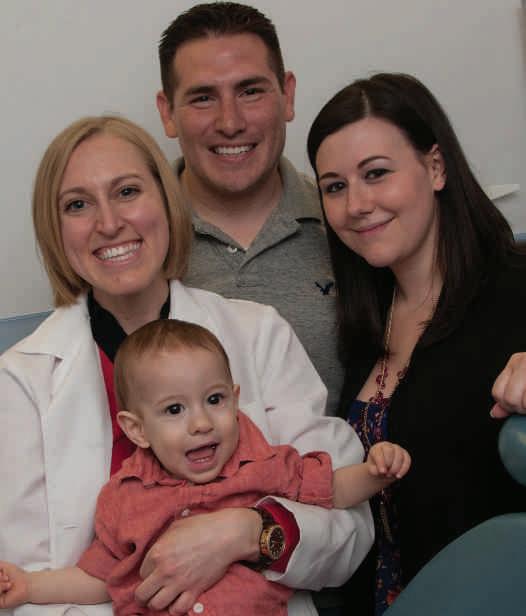
Orlando, Julie and Jacob Almeida with Dr. Shope.
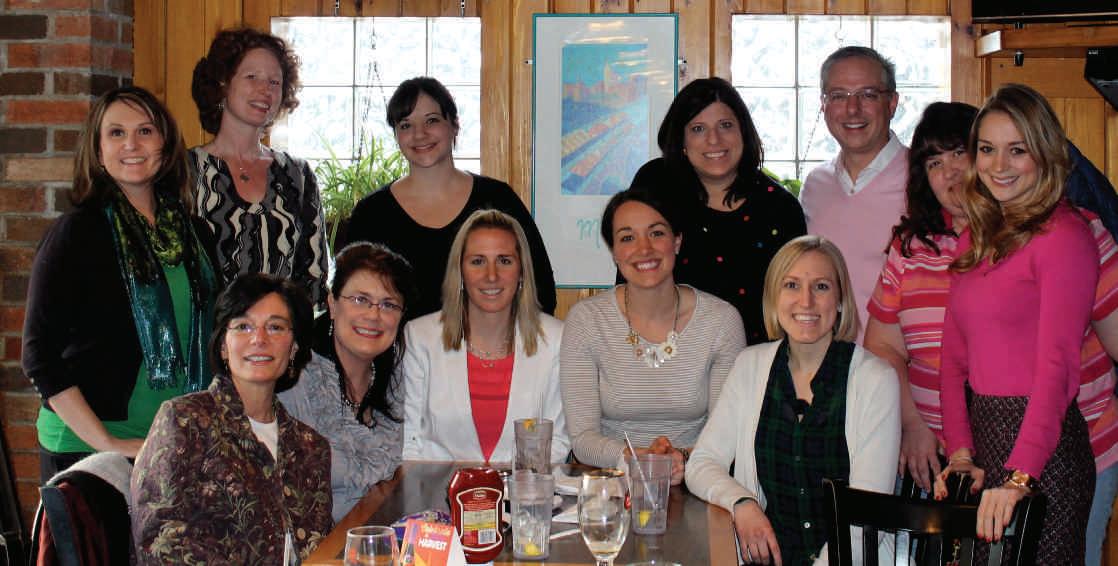
Pediatric Cleft and Craniofacial Anomalies Team. Seated (l to r) Lenora A. Colaruotolo, Social Worker | Mary Therese Biltucci, Dental Coordinator | Dr. Molly LopezCepero, Dental Resident | Claire Beers, Audiologist | Dr. Erin Shope, Dentist. Standing (l to r) Erin Lagoe, Genetic Counselor | Jennifer C. West, Psychologist | Shayna Tokar, Audiologist | Merideth Rao, Speech-Language Pathologist | Dr. John Girotto, previous Director | Jenni Maggi, Secretary | Melisande J. McCheyne, Coordinator | Not pictured, Dr. Renee Lynn Roland, Orthodontist
questioned it, after learning it would make his lip correction and palate correction 10 times better,” said Julie. “At first, we didn’t really know what was going to happen. But Dr. Girotto talked about it like it was no big deal – his demeanor was really awesome, so from then on we accepted it as no big deal.”
Thirty weeks into her pregnancy, Almeida decided to change obstetricians so Jake could be born at Strong. “It was the best decision for us, having immediate access to all these experts who care for cleft babies and Strong’s NICU,” she said.
“I was really impressed right after Jake was born, because Mel and the speech pathologist came and taught us how to feed him with a special bottle,” recalled Julie, who also wrote a blog, Kinda Pregnant, sharing her experience throughout the pregnancy, Jake’s NAM, and his surgeries.
“Jacob’s cleft was about 15mm in width before starting the NAM,” said Shope. “Jacob adapted wonderfully to the NAM and he would even use it as a pacifier. Orlando and Julie were incredible advocates for Jacob and picked up the taping and insertion of NAM readily.”
For three to five months, babies are seen once a week at Eastman to adjust the NAM until their first lip closure surgery.
Together, Shope and the Almeidas gradually made changes to the NAM over the course of four months to bring the alveolar segments and lips closer together. At birth, Jacob’s nose on the side of the cleft was very flat. Using a nasal stent attached to the NAM, they were able to elevate the tip of his nose, as well as make the nose more dome-like and symmetrical.
“Jacob had excellent results. At the time of his lip closure surgery, the cleft was reduced to about 4mm, and his nose was far more symmetrical,” Shope said.
“Dr. Shope was amazing,” Julie said. “She understood a lot of the responsibility was on us, which was very overwhelming and stressful at times.”
“She was always so helpful,” added Orlando, “and was really good about problem solving different issues that would come up.”
Shope even gave the Almeidas her personal cell if they had questions or scheduling problems.
“Overall, it’s been a great experience,” Julie said. “I love that the residents watched his molding and NAM adjustments. The more people who can learn how to do it, the better! We love the unity at Eastman.”
Orlando and Julie are very grateful they have a team of experts in the same town they live. “Dr. Shope can be his dentist, because she understands his needs,” said Julie. “The cleft team has been the most supportive group; we’re so thankful for all the support we’ve had throughout this process, you can’t even know.”
Cleft patients develop a unique partnership between parents and providers. It’s built on a trust and mutual commitment so huge, the relationship many times transcends beyond that of a typical doctorpatient. “Dr. Shope and I are now Facebook friends, that’s how comfortable I feel with her,” said Julie. “I don’t want it be that I never see her again – I really like her.”
At just four days old, Chase Freberg traveled 1.5 hours to get his first consultation, whose parents first found out he had cleft when he was delivered via an emergency C-section.
“It was a very emotional time,” remembered Jesse Freberg. “But with information accessible so quickly from smart phones, we began researching immediately about cleft.”

Jacob’s left nostril beginning to take shape by using the NAM.
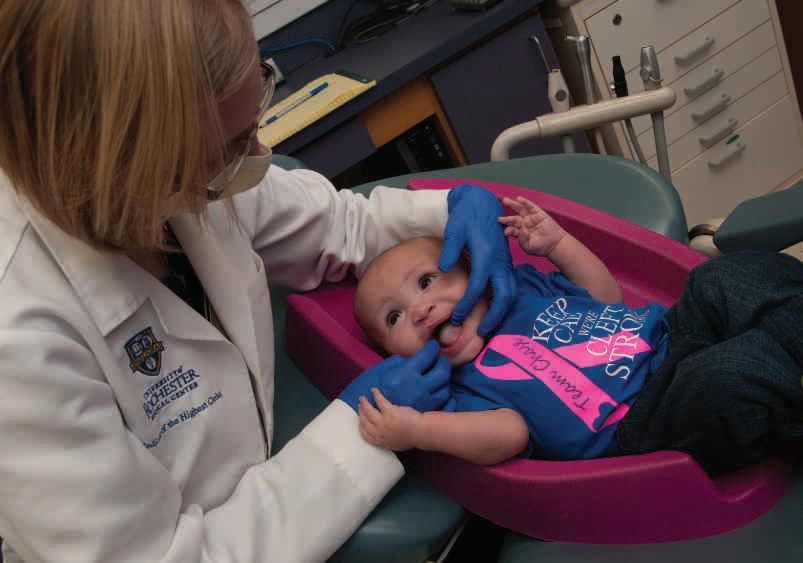
During their research, Jesse and wife Erin, who live 1 ½ hours from Eastman Dental, learned about the NAM.
“No matter how many trips we had to make, we were going to do the NAM, because in the long run, it could eliminate surgeries and it was the best approach for him,” Erin said.
But for the Frebergs, and other families who drive to Eastman Dental each week from as far as Pennsylvania, the cost of gas and parking adds up quickly, not to mention time off work. EIOH Social Work stepped in to help.
“We had applied to a couple organizations that help children financially and were successful in securing gas cards that helped defray the cost of travel significantly,” said Lenora Colaruotolo, EIOH social worker.
“Chase’s cleft was about 15mm in width at the start of treatment,” explained Shope, who treats about eight cases a year. “Chase did well with the NAM until about two weeks before his surgery. He figured out how to dislodge the appliance with his tongue, so we had difficulty keeping the appliance in place. We still had very good results with his cleft at about 5mm.”
“Dr. Shope and Dr. Girotto are amazing, and what they do is amazing,” said Erin, who is initiating fund raising to benefit other families who will one day walk in their shoes and need help. “We so appreciate the wonderful care we received at Eastman and through the cleft team.”
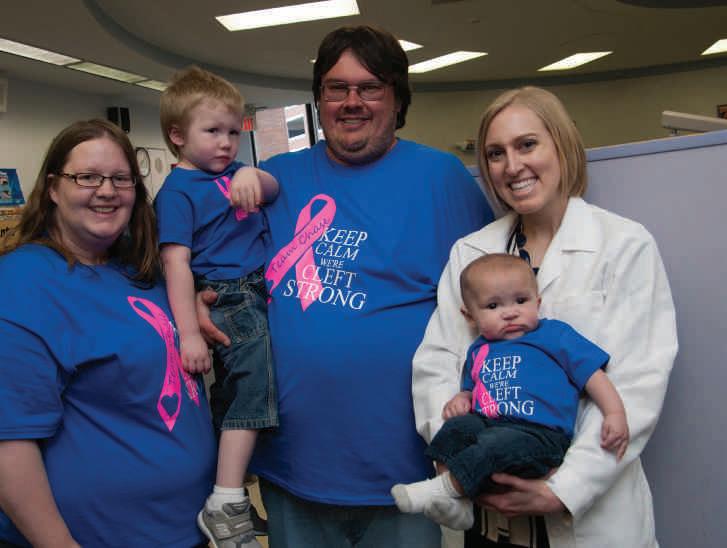
Dr. Shope holds Chase (right) and poses with his mother Erin, brother Weston, and father Jesse.
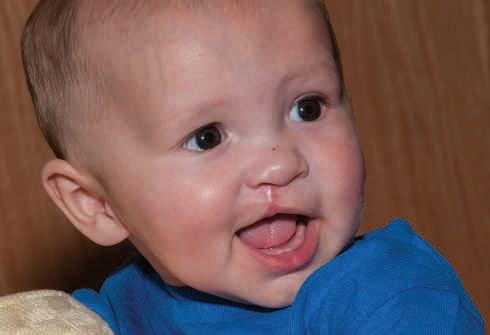
Chase Freberg a few weeks after lip closure surgery.
Eastman.” ~ Julie Almeida







